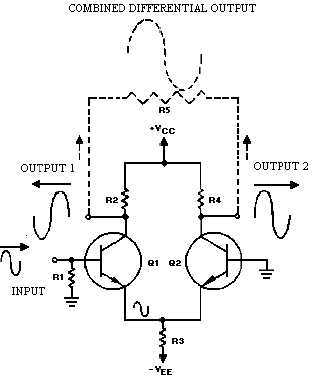3-13
Figure 3-8.—Single-input, differential-output differential amplifier.
This circuit’s operation is the same as for the single-input, single-output differential amplifier just
described. However, another output is obtained from the bottom of R2. As the input signal goes positive,
thus causing increased current through Q1, R2 has a greater voltage drop. The output signal at the bottom
of R2 therefore is negative going. A negative-going input signal will decrease current and reverse the
polarities of both output signals.
Now you see how a differential amplifier can produce two amplified, differential output signals from
a single-input signal. One further point of interest about this configuration is that if a combined output
signal is taken between outputs number one and two, this single output will be twice the amplitude of the
individual outputs. In other words, you can double the gain of the differential amplifier (single output) by
taking the output signal between the two output terminals. This single-output signal will be in phase with
the input signal. This is shown by the phantom signal above R5 (the phantom resistor connected between
outputs number one and two would be used to develop this signal).
DIFFERENTIAL-INPUT, DIFFERENTIAL-OUTPUT, DIFFERENTIAL AMPLIFIER
When a differential amplifier is connected with a differential input and a differential output, the full
potential of the circuit is used. Figure 3-9 shows a differential amplifier with this type of configuration
(differential-input, differential-output).

